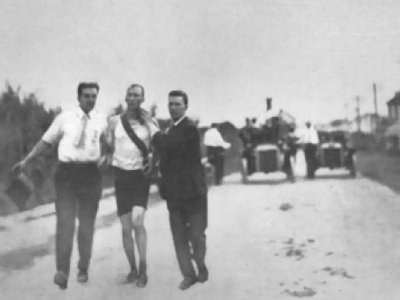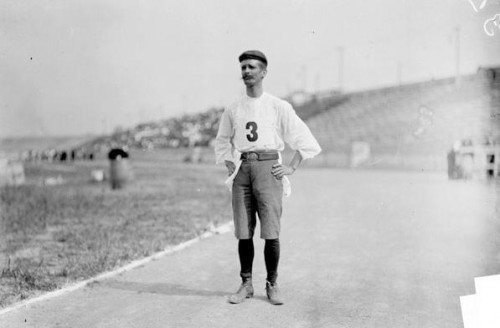The 1904 Olympic Marathon May Have Been the Strangest Ever
In 1904, St. Louis hosted the Olympic Games as part of the World’s Fair—and produced a spectacle that incorporated all the mischief of the midway
/https://tf-cmsv2-smithsonianmag-media.s3.amazonaws.com/filer/1904-Marathon-hero-631.jpg)
America’s first Olympics may have been its worst, or at least its most bizarre. Held in 1904 in St. Louis, the games were tied to that year’s World’s Fair, which celebrated the centennial of the Louisiana Purchase while advancing, as did all such turn-of-the-century expositions, the notion of American imperialism. Although there were moments of surprising and genuine triumph (gymnast George Eyser earned six medals, including three gold, despite his wooden leg), the games were largely overshadowed by the fair, which offered its own roster of sporting events, including the controversial Anthropology Days, in which a group of “savages” recruited from the fair’s international villages competed in a variety of athletic feats—among them a greased-pole climb, “ethnic” dancing, and mud slinging—for the amusement of Caucasian spectators. Pierre de Coubertin, a French historian and founder of the International Olympic Committee, took disapproving note of the spectacle and made a prescient observation: “As for that outrageous charade, it will of course lose its appeal when black men, red men and yellow men learn to run, jump and throw, and leave the white men behind them.”
The Olympics’ signal event, the marathon, was conceived to honor the classical heritage of Greece and underscore the connection between the ancient and modern. But from the start the 1904 marathon was less showstopper than sideshow, a freakish spectacle that seemed more in keeping with the carnival atmosphere of the fair than the reverential mood of the games. The outcome was so scandalous that the event was nearly abolished for good.
A few of the runners were recognized marathoners who had either won or placed in the Boston Marathon or had placed in previous Olympic marathons, but the majority of the field was composed of middle-distance runners and assorted “oddities.” Americans Sam Mellor, A.L. Newton, John Lordon, Michael Spring and Thomas Hicks, all experienced marathoners, were among the favorites. Another American, Fred Lorz, did all his training at night because he had a day job as a bricklayer, and earned his spot in the Olympics by placing in a “special five-mile race” sponsored by the Amateur Athletic Union. Among the leading oddities were ten Greeks who had never run a marathon, two men of the Tsuana tribe of South Africa who were in St. Louis as part of the South African World’s Fair exhibit and who arrived at the starting line barefoot, and a Cuban national and former mailman named Félix Carbajal, who raised money to come to the States by demonstrating his running prowess throughout Cuba, once trekking the length of the island. Upon his arrival in New Orleans, he lost all his money on a dice game and had to walk and hitchhike to St. Louis. At five feet tall, he presented a slight but striking figure at the starting line, attired in a white, long-sleeved shirt, long, dark pants, a beret and a pair of street shoes. One fellow Olympian took pity, found a pair of scissors and cut Carbajal’s trousers at the knee.
On August 30, at precisely 3:03 p.m., David R. Francis, president of the Louisiana Purchase Exposition Company, fired the starting pistol, and the men were off. Heat and humidity soared into the 90s, and the 24.85-mile course—which one fair official called “the most difficult a human being was ever asked to run over”—wound across roads inches deep in dust. There were seven hills, varying from 100-to-300 feet high, some with brutally long ascents. In many places cracked stone was strewn across the roadway, creating perilous footing, and the men had to constantly dodge cross-town traffic, delivery wagons, railroad trains, trolley cars and people walking their dogs. There were only two places where athletes could secure fresh water, from a water tower at six miles and a roadside well at 12 miles. James Sullivan, the chief organizer of the games, wanted to minimize fluid intake to test the limits and effects of purposeful dehydration, a common area of research at the time. Cars carrying coaches and physicians motored alongside the runners, kicking the dust up and launching coughing spells.
Fred Lorz led the 32 starters from the gun, but by the first mile Thomas Hicks edged ahead. William Garcia of California nearly became the first fatality of an Olympic marathon we he collapsed on the side of the road and was hospitalized with hemorrhaging; the dust had coated his esophagus and ripped his stomach lining. Had he gone unaided an hour longer he might have bled to death. John Lordon suffered a bout of vomiting and gave up. Len Tau, one of the South African participants, was chased a mile off course by wild dogs. Félix Carvajal trotted along in his cumbersome shoes and billowing shirt, making good time even though he paused to chat with spectators in broken English. On one occasion he stopped at a car, saw that its occupants were eating peaches, and asked for one. Being refused, he playfully snatched two and ate them as he ran. A bit further along the course, he stopped at an orchard and snacked on some apples, which turned out to be rotten. Suffering from stomach cramps, he lay down and took a nap. Sam Mellor, now in the lead, also experienced severe cramping. He slowed to a walk and eventually stopped. At the nine-mile mark cramps also plagued Lorz, who decided to hitch a ride in one of the accompanying automobiles, waving at spectators and fellow runners as he passed.
Hicks, one of the early American favorites, came under the care of a two-man support crew at the 10-mile mark. He begged them for a drink but they refused, instead sponging out his mouth with warm distilled water. Seven miles from the finish, his handlers fed him a concoction of strychnine and egg whites—the first recorded instance of drug use in the modern Olympics. Strychnine, in small doses, was commonly used a stimulant, and at the time there were no rules about performance-enhancing drugs. Hicks’ team also carried a flask of French brandy but decided to withhold it until they could gauge the runner’s condition.
Meanwhile, Lorz, recovered from his cramps, emerged from his 11-mile ride in the automobile. One of Hicks’ handlers saw him and ordered him off the course, but Lorz kept running and finished with a time of just under three hours. The crowd roared and began chanting, “An American won!” Alice Roosevelt, the 20-year-old daughter of President Theodore Roosevelt, placed a wreath upon Lorz’s head and was just about to lower the gold medal around his neck when, one witness reported, “someone called an indignant halt to the proceedings with the charge that Lorz was an impostor.” The cheers turned to boos. Lorz smiled and claimed that he had never intended to accept the honor; he finished only for the sake of a “joke.”

Thomas Hicks, assisted by his trainers.
Hicks, the strychnine coursing through his blood, had grown ashen and limp. When he heard that Lorz had been disqualified he perked up and forced his legs into a trot. His trainers gave him another dose of strychnine and egg whites, this time with some brandy to wash it down. They fetched warm water and soaked his body and head. After the bathing he appeared to revive and quickened his pace. “Over the last two miles of the road,” wrote race official Charles Lucas, “Hicks was running mechanically, like a well-oiled piece of machinery. His eyes were dull, lusterless; the ashen color of his face and skin had deepened; his arms appeared as weights well tied down; he could scarcely lift his legs, while his knees were almost stiff.”
He began hallucinating, believing that the finish line was still 20 miles away. In the last mile he begged for something to eat. Then he begged to lie down. He was given more brandy but refused tea. He swallowed two more egg whites. He walked up the first of the last two hills, and then jogged down on the incline. Swinging into the stadium, he tried to run but was reduced to a graceless shuffle. His trainers carried him over the line, holding him aloft while his feet moved back and forth, and he was declared the winner.
It took four doctors and one hour for Hicks to feel well enough just to leave the grounds. He had lost eight pounds during the course of the race, and declared, “Never in my life have I run such a touch course. The terrific hills simply tear a man to pieces.” Hicks and Lorz would meet again at the Boston Marathon the following year, which Lorz won without the aid of anything but his legs.
Sources:
Books: Susan Brownell, The 1904 Anthropology Days and Olympic Games. Lincoln: University of Nebraska Press, 2008; David E. Martin, The Olympic Marathon. Champaign, IL: Human Kinetics, 2000. George R. Matthews, America’s First Olympics: The St. Louis Games of 1904. Columbia: University of Missouri Press, 2005; Pamela Cooper, The American Marathon. Syracuse: Syracuse University Press, 1998; Daniel M. Rosen, Dope: A history of Performance Enhancement in Sports From the Nineteenth Century to Today. Westport, Conn: Praeger, 2008; Charles J. P. Lucas, The Olympic Games, 1904. St. Louis, Mo: Woodward & Tieran Printing Co., 1905.
Articles: “The Olympics of 1904: Comedic, Disgraceful, and ‘Best Forgotten.” Wall Street Journal, August 11, 2004; “Marathon Captivated Crowd at 1904 Olympics.” St. Louis Post-Dispatch, December 14, 2003; “New York Athlete Wins Marathon Race.” New York Times, April 20, 1905; “1904 Set Record for the Unusual.” Los Angeles Times, July 24, 1984; “The 1904 Marathon Was Pure Torture.” Cedar Rapids Gazette, August 3, 2008; “Marathon Madness,” New Scientist 183 (August 7-13, 2004); “St. Louis Games Were Extremely Primitive By Today’s Standards.” St. Louis Post-Dispatch, August 2004; “One Man’s Poison In a Brazen and Forgotten Incident of Doping.” Boston Globe, February 22, 2009.
/https://tf-cmsv2-smithsonianmag-media.s3.amazonaws.com/accounts/headshot/karen-abbot-240.jpg)


/https://tf-cmsv2-smithsonianmag-media.s3.amazonaws.com/accounts/headshot/karen-abbot-240.jpg)